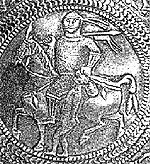Shortly after the death of Mohammed in AD 632, according to Columbia University Professor, D. M. Dunlop, Arab armies began a campaign northward, sweeping "through the wreckage of two empires and carrying all before them till they reached the great mountain barrier of the Caucasus. This barrier once passed," Dunlop observes, "the road lay open to the lands of eastern Europe." 2 Had the Caliphate (the armies of the Muslim Caliph) surmounted that immense geological deterrent unchallenged, the history of Europe and, indeed, the rest of the Judeo-Christian world would have been vastly different than it now is.
It was at the Caucasus, however, that the Arabs encountered the Khazars, initiating a war that lasted over a century and effectively prevented Europe from becoming Islamic. So powerful, socially and militarily, were the Khazars that, as Kevin Alan Brook relates in his work The Jews of Khazaria, "a 10th-century emperor of the Byzantines [Roman Empire], Constantine Porphyrogenitus, sent correspondence to the Khazars marked with a gold seal worth 3 solidi - more than the 2 solidi that always accompanied letters to the Pope of Rome, the Prince of the Rus, and the Prince of the Hungarians." 3
Rutgers University Professor Peter Golden, referred to by Brook as "one of the principal authorities on the Khazars," wrote, "Every schoolchild in the West has been told that if not for Charles Martel and the battle of Poitiers there might be a mosque where Notre Dame now stands. What few schoolchildren are aware of," Golden emphasizes, "is that if not for the Khazars...Eastern Europe might well have become a province of Islam." 4
The Khazarian mounted forces, with a soldiery of mainly Turkic and pagan origin, could at times and when accounted for, show a disastrous fierceness and cruelty to the enemies of Khazaria. They were also probably the most disciplined, as well as tactically and strategically the most potent, martial power at that time and in that region. Evidence that they were supremely calculating in their approach to international matters lay in the fact that, in contrast to their brutality, Khazar officials were often consulted as diplomatic emissaries and mediators by all the political powers surrounding Khazaria. The Khazars and their empire were at that time both highly respected and greatly feared -- with good reason. 5
At the peak of their empire it is believed that the Khazars had a permanent standing army that could have numbered as many as one hundred thousand and controlled or exacted tribute, astonishingly, from thirty different nations and tribes inhabiting the vast territories between the Caucasus, the Aral Sea, the Ural Mountains and the Ukrainian steppes. 6 , 7 During their zenith, Khazaria completely girded the lands of what are currently Astrakhan, Kalmykia, Daghestan, Volgograd, Rostov, Ingushetia, Kabardino-Balkarsk, North Ossetia, and Chechnya. "At its maximum extent (in the ninth century)," says Brook, "Khazaria not only encompassed the northern Caucasus and the Volga delta, but also extended as far west as Kiev [Russia]." 8
Soviet archaeologist M. I. Artamonov states that, for a century and a half, the Khazars were the supreme masters of the southern half of Eastern Europe and presented a virtually impenetrable bulwark, blocking the Ural-Caspian gateway from Asia into Europe. During that entire period, they held back the onslaught of the nomadic tribes from the East. 9
Until recently, a great part of the problem with the historical obscurity of ancient Khazaria lay with the fact that the geographical area of the country was part of the Soviet Union, which insisted on interpreting archaeological data "within the framework of Marxist historical materialism." 10 This Iron Curtain version of historical revisionism caused the Soviets to interpret that data in such a way as to present as fact that which was well fabricated -- but wrong.
This peculiar and obscure race inhabiting that land were described as blue-eyed and of very fair complexion. Commonly they had long reddish hair and were reported as very large of stature and fierce of countenance. 11 Other sources have added observations that there were "Black Khazars" and "White Khazars," noting that the latter were "light-skinned and handsome, while the former were dark-skinned." This has, however, been rather conclusively refuted by scholars who have established that the distinction was not racial but social. The "Black" or "Kara" Khazars constituted the lower strata or caste, while the "White" or "Ak" Khazars were of the noble or royal classes. This type of class distinction was fairly common in Eastern Europe as evidenced by the more commonly known terms "Black Russian" and "White Russian," denoting not skin color but class. 12
In his book An Introduction to the History of the Turkic Peoples, Peter Golden claims that the Chinese T'and-shu chronicle describes the Khazars, generally, as "...tall, with red-hair, ruddy-faced and blue-eyed. Black hair is considered a bad omen." 13
